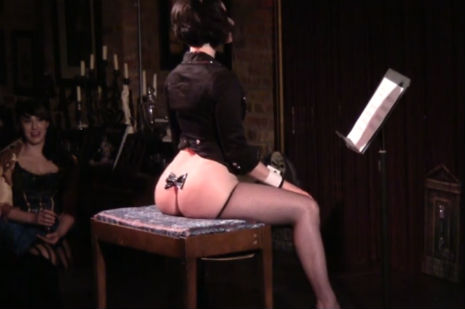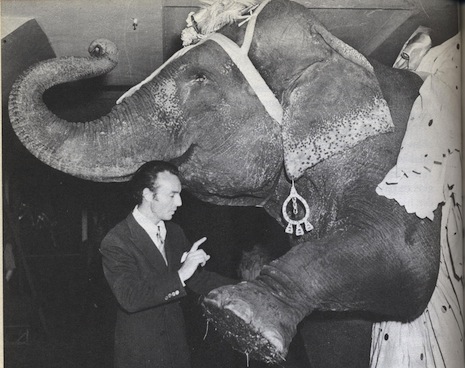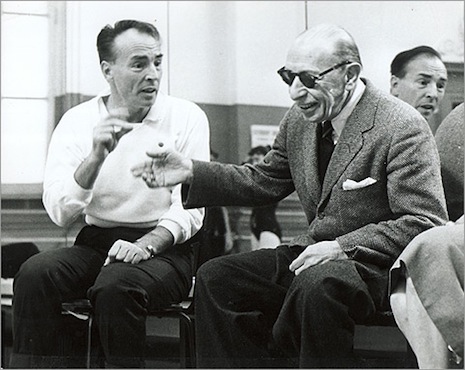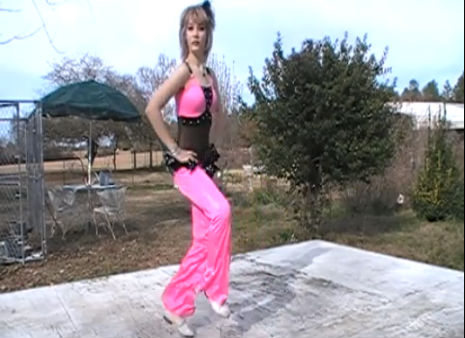
The 1% be twerkin’ it up in style to “Butthoven’s 5th Symphony.”
In actuality, this is burlesque performer Michelle L’amour who has amazing capabilities with her buttcheeks. I mean, amazing!

The 1% be twerkin’ it up in style to “Butthoven’s 5th Symphony.”
In actuality, this is burlesque performer Michelle L’amour who has amazing capabilities with her buttcheeks. I mean, amazing!

As an unabashedly “elite” pursuit, ballet has often struggled to find audience. Similar to opera only more so, ballet people have frequently obsessed about how to attract new demographic groups to its art. In 1993 the ballet world witnessed a fascinating experiment in crossing over: partnering with his Purple Badness himself, Prince—or, as he was known at that time, [unpronounceable glyph]—to create Billboards, mounted by the esteemed Joffrey Ballet. The legacy of Billboards is mixed, to say the least.
The Joffrey Ballet, founded in New York by Robert Joffrey and Gerald Arpino, has generally represented the more experimental end of the ballet spectrum. They were unafraid to commission works from figures from modern dance such as Alvin Ailey or Twyla Tharp. At some point, Prince caught some of the Joffrey Ballet’s “mixed rep,” and was so inspired that he pledged to compose some music for the troupe to perform to. Whether that actually happened is not entirely clear—the resultant 1993 ballet relies almost entirely on preexisting music, with the exception of a 10-minute orchestral version of “Thunder,” off of his 1992 album Diamonds and Pearls,which Prince did compose.

A still from the Joffrey Ballet’s 1993 work Billboards
Prince permitted the use of his catalog without asking for royalties. Billboards is a four-part piece, each part choreographed by a different person: Laura Dean, Charles Moulton, Margot Sappington, and Peter Pucci. Billboards raids liberally from Purple Rain, using the title track, “Baby I’m a Star,” “Computer Blue,” and “The Beautiful Ones,” as well as scattered picks off of Sign O’ the Times, Batman, Graffiti Bridge, Diamonds and Pearls, and Parade.
Here’s the breakdown of the pieces in Billboards and the songs they used:
I: Sometimes It Snows in April (choreographed by Laura Dean)
“Sometimes It Snows in April”
“Trust” / “Baby I’m a Star”II: Thunder (choreographed by Charles Moulton)
“Thunder”
“Purple Rain”III: Slide (choreographed by Margo Sappington)
“Computer Blue”
“I Wanna Melt with U”
“The Beautiful Ones”
“Release It” / “Computer Blue” (Reprise)IV: Willing & Able (choreographed by Peter Pucci)
“For You”
“The Question of U”
“It”
“Willing and Able” / “Gett Off”
Billboards premiered on January 27, 1993, at the University of Iowa’s Hancher Auditorium in Iowa City, Iowa. In November the piece moved to New York—where the critical reception was not altogether forgiving.
The first sentence of Anna Kisselgoff’s review in the New York Times of November 28, 1993, is “If only it had been better.” She continued:
“Billboards” is nonetheless an attempt to expand upon the company’s pioneering rock ballets of the past. ...
“Billboards” does not have the coherence and choreographic power of these works, but, like them, it sums up an era of pop esthetics. Similarly, its importance lies in an ability to interpret American youth culture to a mainstream dance audience—which should not be confused with its other goal of attracting new, young audiences.
“Billboards” could not have been done in the 1960’s; it evokes MTV with its frontal assault on the audience through loud sound and clever changes in lighting (by Howell Binkley). The choreography deliberately includes a great deal of posturing; there are also the coded gestures common to voguing, the dance style born in gay minority clubs and derived from fashion-model poses. ...
Rather than just exploit the varied range of Prince’s rhythms, they comment on the music and by extension, the rock scene as a whole.Working from a 1990’s safe-sex perspective, the choreographers ignore Prince’s calls for salvation through sex. MTV’s crotch-grabbing comes in for considerable parody. The naughtiness is tame: “Billboards” is a family show.
In the end, “Billboards” is only as good as its choreography, and here Ms. Dean, in the first section, “Sometimes It Snows in April,” is the clear winner. Prince’s ambiguous ballad about a dead friend is treated abstractly but lyrically by the choreographer, as the male and female dancers slink into diagonals, repeating turns and plies. New movement phrases overlap with the old. Individuals pair up for slow and amplified ballet lifts (the women are on toe).
Tobi Tobias in New York magazine was considerably harsher:
There have always been two Joffrey Ballets. One of them loves history. … The other company pays the bills.
Absent from the city for well over two years, … the Joffrey returned—for seven performances at [the Brooklyn Academy of Music]—with a single offering: the evening-length Billboards, to largely stupefying songs from Prince, its four sections choreographed separately. … It will find its audience, no doubt, but there will be few balletomanes in it. Indeed, one of the most horrifying things about this display is the murderous contempt it harbors for traditional dance values….
What else is wrong with Billboards? The choreography goes along with the premises of the music like so much visual accompaniment. Instead of providing a distanced irony or, at the very least, comment, it pretends to be part of Prince’s synthetically hip and orgiastic world and fails wretchedly; it looks like something resurrected from the sixties. Dean’s “Sometimes It Snows in April” is the only piece hurtling toward the junkyard of abandoned virtue that gives our old friends rhythm and pattern a backward glance. Still, it’s simplistic even for Dean and, as usual, opportunistic, incorporating her original trademarks, uninflected repetition and whirling; ballet conventions she annexed subsequently, working for the Establishment; and, to suit the present circumstances, her take on jazz movement, which is embarrassingly trite.
Margo Sappington’s “Slide” is the most viable entry, though I wouldn’t call it dancing. It’s a presentation in images of the teenage male’s romantic fantasies. A bunch of aw-shucks jocks from a past decade (the fifties that preceded Oh! Calcutta!?) conjure up a trio of sweetly lethal dreamboats for some inconclusive fooling around. Real choreography is irrelevant to the piece, which is essentially an amalgam of picturesque behavior and an effective set.
The show was a massive financial success, but just two years later the Joffrey Ballet found itself experiencing financial difficulties. According to The Oxford Dictionary of Dance by Debra Craine and Judith Mackrell, “In 1995 the Joffrey was suffering a financial crisis and had to relocate from New York to Chicago.”
Here’s an Australian TV piece about Billboards:
Here is a bit of Peter Pucci’s section of Billboards, “Willing & Able”:

A few assertions about this video.
This video is designed to puzzle stodgy old people—I include myself in that group. This video has everything that appeals to youth in it, and nothing that makes sense to old people. We have finally attained maximum youthiosity.
This video is mildly NSFW unless you work in an anime production shop.
If this video is any indication, vogueing is one part breakdancing and one part being a spaz.
The world sorely needs more dancing competitions that involve cosplay.
The only word that adequately describes this video is “COMMITMENT.”
(via Lost at E Minor)

George Balanchine mollifying a temperamental ballet dancer
If there’s one thing New York City lacks nowadays, it’s ballets by major composers with elephants in them….
Cast your mind back more than seventy years ago. It’s Thursday, April 9, 1942. The country is at war. You’re in New York, and you have a free evening at your disposal. What to do?
Here are a few suggestions. If you’d like to see a movie, there’s a brand new comedy called My Favorite Blonde starring that wonderful young comedian Bob Hope. But perhaps you’re in the mood for live performance. Let’s see…. At the Imperial Theatre on West 45th Street you can catch the new Cole Porter musical Let’s Face It! starring Danny Kaye and Eve Arden, or over at the Majestic Theatre a block down on 44th, there’s always George Gershwin’s masterpiece Porgy and Bess.
Or wait—what am I thinking!? There’s no way you’re not going to want to attend the world premiere of the elephant polka choreographed by George Balanchine and composed by Igor Stravinsky, right? That happens tonight at Madison Square Garden on Eighth Avenue between 49th and 50th, let’s get a move on before it sells out! (Yes, that’s where MSG was located between 1925 and 1968.)
This actually happened. The “father of American ballet” and arguably the most innovative composer of the pre-WW2 period really did partner up to write a performance for fifty elephants (with fifty ballerinas on top of them) for the Ringling Bros. Barnum & Bailey Circus. The resultant work was called “Circus Polka: For a Young Elephant.” The elephants, all fifty of them, wore pink tutus.
Not too surprisingly, the crowd loved it.

Balanchine and Stravinsky in 1957, possibly discussing a tarantella arranged for panda bears.
According to Stephen Walsh’s entertaining account in Stravinsky: The Second Exile: France and America, 1934-1971, here’s how it all went down:
[H]e was telephoned from New York by Balanchine, who had been approached by Ringling Brothers and Barnum and Bailey’s Circus to choreograph a polka for the circus elephants, and wanted Stravinsky to compose the music. Stravinsky told him that he could not write even a short piece before March. . . . All the same he certainly tinkered with the idea long before that. He noticed that by an odd coincidence there were polka rhythms everywhere in the Danses concertantes, and at about Christmastime he started sketching ideas for the elephant piece while still working on the ending of the Danses. Then, as soon as that work was finished, he rapidly composed the Circus Polka as a piano solo and completed the draft score by the 5th of February. The point about this, for him, slightly unusual way of working was that Ringling would need a score for a circus band, and for the first time in his life Stravinsky did not feel equal to the task. So he approached the best-known Hollywood arranger of the day, Robert Russell Bennett, and Bennett recommended a young composer called David Raskin—a pupil of Schoenberg, as it turned out, and already an experienced filmwriter—who duly orchestrated the polka for the bizarre combination of wind and percussion instruments (including Hammond organ) that Ringling had assembled for their circus performances.
As a piece of barefaced opportunism, the Circus Polka was hard to beat. A few years later Stravinsky gratefully accepted a Canadian interviewer’s suggestion that the piece was a musical equivalent of the circus paintings of Toulouse-Lautrec, but at the time he was mainly concerned to write it as quickly as possible for the biggest fee Balanchine could get him. Later still, he reconstructed the original phone conversation in terms of an imaginary aesthetic discrimination. “I wonder if you’d like to do a little ballet with me, a polka perhaps,” Balanchine is supposed to have said. “For whom?” “For some elephants.” “How old?” “Very young.” (After a pause) “All right. If they are very young elephants, I will do it.” As for the music, the piece galumphs amusingly enough through vestiges of rhythmic ideas from the Danses concertantes reimagined for pachyderms, with an unexpected nod at one point toward Tchaikovsky’s Fourth Symphony, and ending with a heavily underlined and quotation-marked parody of the same Schubert march that he had merely hinted at in the Janssen score.
In fact the ballet—which Stravinsky never saw—was danced, when the circus opened at New York’s Madison Square Garden on the 9th of April, by fifty elephants in pink tutus, all apparently of mature age, like the fifty girls who sat atop them. At their head, lovely Vera Zorina rode in on Old Modoc, the chief and oldest elephant.
As carefully as if La Zorina were spun glass—which she is!—
the giant deposited her in the center of the forest of elephants,
and when she had completed her exquisite pirouetting upon
the sawdust picked her up and carried her away. But not
before she had handed [Modoc] a huge bunch of American
Beauties, which he promptly coiled up in his trunk like
a commuter filing his copy of The New York Sun under
his arm to read after dinner.
-snip-Fortunately there was no stampede except at the box office, and though the Ringlings never revived the piece after the first season, the publicity it attracted served them well until, after less than two months, the band was paid off because of a pay dispute, and the circus continued with gramophone recordings, which of course precluded the Stravinsky ballet.
Here’s some of the music:
And here’s a brief documentary clip about the elephant ballet, which is still pretty diverting even though it’s entirely in Russian:
Boy are they ready!
This is a moment of true greatness, the best thing you’ll see all day. This shit takes flight:
September 5th, 2013, Raleigh, NC - As Walmart workers petition managers to reinstate employees who have been unfairly treated, a flash mob breaks out.
I wish I’d have witnessed this in person, but it’s thrilling just to see it on YouTube. The participants must have felt fantastic afterwards.
The deer-in-the-headlights looks the managers have on their mugs is priceless!

I’ve tried my damnedest the past few weeks not to post anything twerk-related on DM. That is… until I watched this. I hope this will be the only (and hopefully last) twerking session ever on Dangerous Minds.
According to the young woman in the video:
I tried making a sexy twerk video for my boyfriend and things got a little too hot
The rest is, well… history!
h/t Adam Wade!

John Cage, the musician, musical theorist, artist, composer, philosopher, avid mycologist, writer and one of the leading lights of the 20th century avant garde was born on September 5, 1912. Cage’s iconoclastic approach to music—and everything else he did—is neatly summed up in this short comment:
After I had been studying with him for two years, [Austrian composer Arnold] Schoenberg said, “In order to write music, you must have a feeling for harmony.” I explained to him that I had no feeling for harmony. He then said that I would always encounter an obstacle, that it would be as though I came to a wall through which I could not pass. I said, “In that case I will devote my life to beating my head against that wall.”
Superb! I hate to admit it, but I’d rather read John Cage than actually listen to his music. Like most people, the only song of his that I can sing in the shower is “4′33″ although I have a shelf full of his books, books about him and anthologies of his interviews.
I do have a slightly funny John Cage anecdote: Sometime in the mid-1980s, Cage, along with Winona Ryder and several other cultural notables, was photographed for an ad campaign for The GAP. These black and white ads were in magazines and on bus shelters in major cities. New York was just plastered with them at the time (Sadly I can’t find Cage’s ad on Google Images).
Part of the pay, apparently, was a rather large GAP gift certificate and on a day that I happened to be in a GAP store on Seventh Ave and 23rd Street—and had literally just passed his ad on the way into the store—John Cage decided that he was going to spend his. I heard him explaining this to the employees—that he had $1000 to spend—and could they please assist him spending it? They at least seemed to recognize Cage from his GAP ad, if not his actual achievements and the staff was happy to help out the cool old guy in the ad.
Cage didn’t stay long because he seemed to know exactly what he wanted. I recall that he walked out with a winter corduroy coat, a big stack of black “pocket tee” shirts, some denim shirts and some blue jeans. His style of shopping was extremely utilitarian. He left nothing to chance…
Below, the fascinating ‘American Masters’ documentary on John Cage, ‘I Have Nothing to Say and I Am Saying It’:
Below, a seldom-seen cable access program with Cage with his friend, writer Richard Kostelanetz. The pair discuss James Joyce and more:

Whenever I think of Siouxsie & the Banshees my mind naturally wanders to clogging… in tap shoes, in a belly dancer’s outfit.
Via Arbroath

Ladies and gentlemen, all the way from disco-licious Italy, let me introduce you to the wonderful Hard Ton!
This Italian house music performer comes across like the bastard offspring of Divine and Sylvester (and with more than a little Leigh Bowery to satisfy your outlandish-costume-and-make-up needs.) Hard Ton makes a righteous, soulful noise that harks back to the original pioneers of sleazy, seedy Chicago house like Mr Fingers and Robert Owens. In a sea of anonymous dance-music acts that seem happy to bask in the hazy glow of their battered MacBooks, Hard Ton stands out not just for making authentically retro-sounding house, but for making a huge visual statement that reminds us that house was once the realm of the weirdos and the outcasts.
Hard Ton is actually a duo composed of Mauro Wawashi, a formidable producer and DJ in his own right, and vocalist/front person Max, here taking a break from his day job in various metal tribute acts to channel his inner disco diva, including wrapping himself up in the kind of glad rags that would make a hooker blush. Being quite the big guy, this in itself is a bit of a statement, and a beautiful act of plus-size body positivity. Not surprisingly, Hard Ton are fast gaining a hardcore following among the gay bear community.
To my shame, I have known Hard Ton for quite a while now (we even shared a label, Dissident, a few years back) but have failed to feature them on Dangerous Minds before. Let’s remedy that right away! With a new EP to promote and a current tour of the States for Pride season, I sent the formidable Max some questions to wrap his tongue, and brain, around.
The Niallist: Who and what is Hard Ton?
Hard Ton: A multi-sensorial experience: you can dance to me, you can watch me, you can touch me. Sometimes you can also bite me.
The Niallist: What inspires you musically?
Hard Ton: Acid house, disco music, pop. But I suppose I got inspired from everything I ear, it could be a techno track in an underground club, a metal song in a concert, or the shit played on the radio. Outside of music I find inspiration in pop culture, club culture, photography, fashion and art. Well, some fashion and some art. And definitely all the queens who stood up against the police at Stonewall back in 1969!
The Niallist: What can someone expect form a Hard Ton show?
Hard Ton: A ton of meat screaming like a real diva.
The Niallist: What is the strangest reaction you have had live?
Hard Ton: A guy kissed me in front of his girlfriend while I was singing, and I’m not talking about that kind of kiss that your mama would give you…
The Niallist: What is in the near future for Hard Ton?
Hard Ton: Our new E.P. has just been released [via Killekill Records - check it out here], and we are very proud of it. We’ve also just finished a remix for S’Express, and produced some tracks for Paul Parker. And of course we are working on new tracks. As for an album… is there really anyone who still buys CDs? Well, I do!
Hard Ton “Work That Body”
You can find Hard Ton on Facebook, and keep up with the latest news via Hard Ton’s Twitter.

Here’s a first: even though Neneh Cherry and Ari Up both sang in The Slits as teenagers, they have never been immortalised on wax together. Until now.
Thanks to the Swedish act House Of Wallenberg—whose work with the late Harlem ballroom queen Octavia St Laurent we covered here—these two legends can finally be found on the one song, a catchy little dance-pop ditty taken from the appropriately titled album Legends.
Sadly, Ari Up passed away a few years ago, but Neneh Cherry is still touring, and, in fact, has special appearances lined up for this year’s Manchester International Festival. I’m glad somebody finally made a record featuring these two!
Below, House Of Wallenberg featuring Neneh Cherry and Ari Up, “Real Woman”: